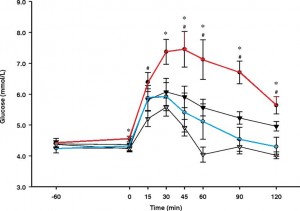calories, proper. Sticking to the data-
Today’s study: aerobic exercise is good for you, but bad for muscular size and strength.
The HART-D trial was a 9 month exercise study which compared resistance (RT), aerobic (AT), and combined (combo) training. Combo did a lot less resistance exercise than RT, and a little less aerobic training than AT. The primary outcome measure was glycated hemoglobin, which combo improved the most, but I am primarily interested in Table 4.
Effects of Aerobic and Resistance Training on Hemoglobin A1c Levels in Patients With Type 2 Diabetes
To start out with my conclusion, I think this study shows that aerobic training is bad for muscle, fat loss, and strength (albeit due to a very small statistically non-significant extent). In short, aerobic exercise is softening (in a small statistically non-significant manner).
The exercise interventions were good.
Aerobic training (AT & combo groups)
150 min/wk of moderate intensity (50-80% VO2max) (?10-12kcal/kg BW*week)
Aerobic: 12 kcal/kg*wk x 98.2 kg = 1170 kcal /wk 623.7-681.9 MET/min*wk
Combo: 10 kcal/kg*wk x 100.6 kg = 1006 kcal /wk 532.0-572.8 MET/min*wk
Resistance training (RT & combo groups)
Days/wk sets x exercises ( x 10-12 reps)
RT: 3 2 x 4 upper, 3 x 3 lower, 2 abs
Combo: 2 1 x 4 upper, 1 x 3 lower, 1 abs
Basically the combo group did about 33% of the resistance training and 80% of the aerobic training as RT and AT, respectively. They all exercised for 140 minutes per week which burnt approximately 1200 kilocalories. In brief, the combination regimen achieved the biggest reduction in glycated haemoglobin while simultaneously reducing blood glucose-lowering medications more than any other group. That is a pretty nice finding, but I think the data presented in Table IV are of critical importance to anyone concerned with body composition, physical performance, and quality of life in general.

Observations:
Aerobic training alone reduced fat-free mass… Their muscles got smaller (3rd row, 4th column).
Aerobic training alone reduced strength… They got weaker (3rd row, 5th column).
The aerobic training alone group lost the least amount of fat mass despite reducing their food intake the most (3rd row, 1st and 3rd columns). I repeat: the aerobic training alone group lost the least amount of fat mass despite reducing their food intake the most…
I can’t entirely explain this, however I would guess that either:
1) Aerobic exercise makes you so tired for the rest of the day that you just lie around doing nothing, expending much less energy. Or
2) Measurement errors, which might be important considering the small overall differences between groups.
Moving on,
Any group that resistance trained (RT & combo) lost more fat mass and gained more strength than those who didn’t (aerobic only)
Resistance training alone increased fat-free mass (also confirms the adequacy of the resistance training regimen… in other words, if muscle mass & strength didn’t respond to the resistance exercise, I wouldn’t consider this a good study.)
Resistance training in the combination group probably would’ve increased muscle mass if it wasn’t for that darned muscle-burning aerobic exercise 🙂
The combo group lost the most fat while reducing their food intake the least. From this I would recommend combination training, however this group also had no improvements in muscle mass and only a modest increase in strength, two things that are very important for quality of life.
In conclusion, resistance training prevailed in this study. Aerobic training is still important for patients with congestive heart failure, so combination training may be more appropriate for this population (and for people with chronic hyperglycaemia), however for the rest of us, resistance training is superior.
Thoughts?
Calories, proper.










